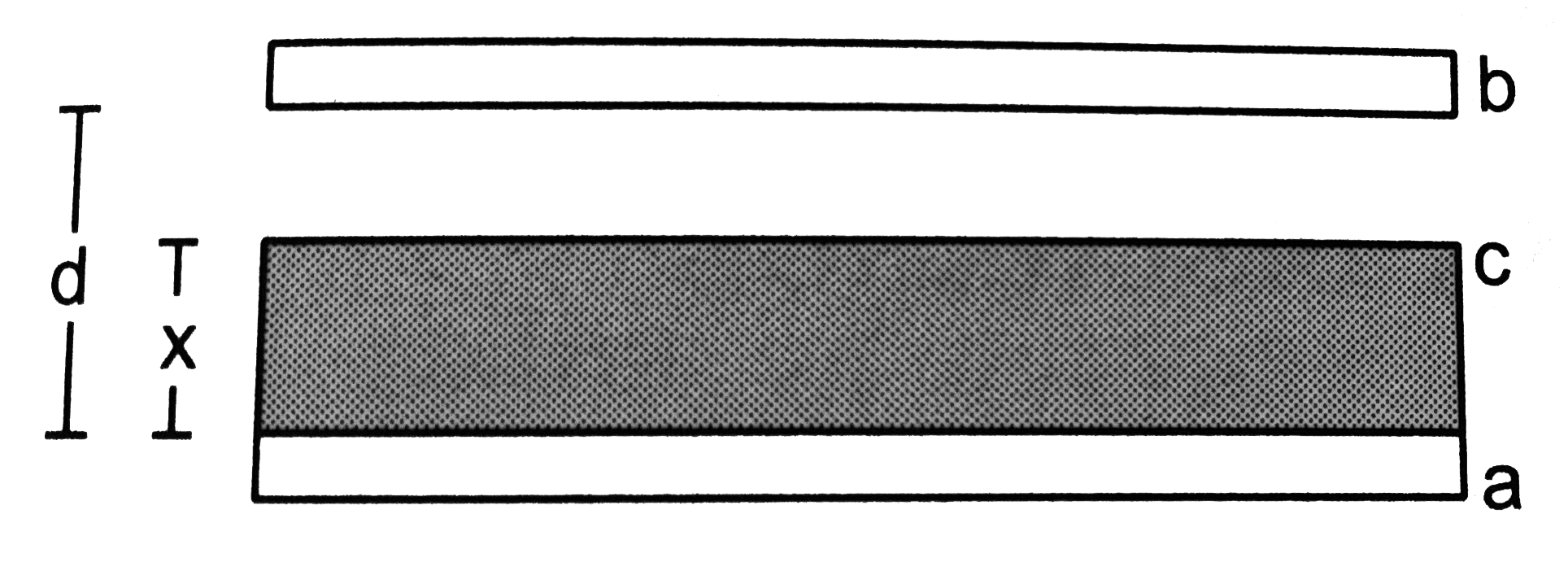Separation between the plates of a parallel plate capacitor is d and the area of each plates is A. When a slab of material of dielectric constant k and thickness t(t<d) is introduced between the plates. Its capacitance becomes
ε0Ad+t(1−1K)
ε0Ad+t(1+1K)
ε0Ad−t(1−1K)
ε0Ad−t(1+1K)
The correct Answer is:C
To find the capacitance of a parallel plate capacitor when a dielectric slab is introduced, we can follow these steps:
Step 1: Understand the Configuration
We have a parallel plate capacitor with:
- Plate separation: d
- Area of each plate: A
- Dielectric slab thickness: t (where t<d)
- Dielectric constant of the slab: k
Step 2: Determine the Effective Capacitance
When the dielectric slab is introduced, the capacitor can be thought of as two capacitors in series:
1. The first capacitor has a dielectric slab of thickness t and dielectric constant k.
2. The second capacitor has air (or vacuum) with thickness d−t.
Step 3: Calculate Capacitance of Each Section
1. Capacitance of the dielectric section:
C1=kϵ0At
where ϵ0 is the permittivity of free space.
2. Capacitance of the air section:
C2=ϵ0Ad−t
Step 4: Combine the Capacitances
Since C1 and C2 are in series, the total capacitance C is given by:
1C=1C1+1C2
Substituting the expressions for C1 and C2:
1C=tkϵ0A+d−tϵ0A
Step 5: Simplify the Expression
Combine the fractions:
1C=t+(d−t)kkϵ0A
1C=dkkϵ0A
Step 6: Solve for Capacitance
Taking the reciprocal gives:
C=kϵ0Adk+(d−t)
Final Expression
Thus, the capacitance of the capacitor with the dielectric slab inserted is:
C=Aϵ0d−tk+t
We have a parallel plate capacitor with:
- Plate separation: d
- Area of each plate: A
- Dielectric slab thickness: t (where t<d)
- Dielectric constant of the slab: k
When the dielectric slab is introduced, the capacitor can be thought of as two capacitors in series:
1. The first capacitor has a dielectric slab of thickness t and dielectric constant k.
2. The second capacitor has air (or vacuum) with thickness d−t.
1. Capacitance of the dielectric section:
C1=kϵ0At
where ϵ0 is the permittivity of free space.
C2=ϵ0Ad−t
Since C1 and C2 are in series, the total capacitance C is given by:
1C=1C1+1C2
1C=tkϵ0A+d−tϵ0A
Combine the fractions:
1C=t+(d−t)kkϵ0A
1C=dkkϵ0A
Taking the reciprocal gives:
C=kϵ0Adk+(d−t)
Thus, the capacitance of the capacitor with the dielectric slab inserted is:
C=Aϵ0d−tk+t
Topper's Solved these Questions
- ELECTROSTATIC POTENTIAL AND CAPACITORSBOOK - DC PANDEY ENGLISHCHAPTER - ELECTROSTATIC POTENTIAL AND CAPACITORSEXERCISE - (B) Chapter exercises
17 Videos
- ELECTROSTATIC POTENTIAL AND CAPACITORSBOOK - DC PANDEY ENGLISHCHAPTER - ELECTROSTATIC POTENTIAL AND CAPACITORSEXERCISE - (C) Chapter exercises
50 Videos
- ELECTROSTATIC POTENTIAL AND CAPACITORSBOOK - DC PANDEY ENGLISHCHAPTER - ELECTROSTATIC POTENTIAL AND CAPACITORSEXERCISE - Check point 2.5
20 Videos
- ELECTROMAGNETIC WAVESBOOK - DC PANDEY ENGLISHCHAPTER - ELECTROMAGNETIC WAVESEXERCISE - Sec C
22 Videos
- ELECTROSTATICSBOOK - DC PANDEY ENGLISHCHAPTER - ELECTROSTATICSEXERCISE - Medical entrances gallery
37 Videos
Similar Questions
Find out the capacitance of parallel plate capacitor of plate area A and plate separation d.
View SolutionA battery charges a parallel plate capacitor of thickness (d) so that an energy [U0] is stored in the system. A slab of dielectric constant (K) and thickness (d) is then introduced between the plates of the capacitor. The new energy of the system is given by
View SolutionThe two plates of a parallel plate capacitor are 4mm apart. A slab of dielectric constant 3 and thickness 3mm is introduced between the plates is so adjusted that the capacitance of the capacitor becomes 23rd of its original value. What is the new distance between the plates ?
View SolutionIf the separation between the plates of a capacitor is 5 mm , then area of the plate of a 3 F parallel plate capacitor is
View SolutionThe capacity of a parallel plate capacitor formed by the plates of same area A is 0.02μF with air as dielectric. Now one plate is replaced by a plate of area 2A and dielectric (k=2) is introduced between the plates, the capacity is
View SolutionFind an expression for the capacitance of a parallel plate capacitor when a dielectric slab of dielectric constant K and thickness t=d2 but the same area on the plates is inserted between the the capacitors plate. (d=separation between the plates)
View SolutionThe force between the plates of a parallel plate capacitor of capacitance C and distance of separation of the plates d with a potential difference V between the plates, is.
View SolutionA parallel plate capacitor has plate area A and plate separation d. The space betwwen the plates is filled up to a thickness x (ltd) with a dielectric constant K. Calculate the capacitance of the system.

View SolutionHalf of the space between the plates of a parallel plate capacitor is filled with dielectric material of constant K. Then which of the plots are possible?
View SolutionThe separation between the plates of a parallel-plate capacitor is 0.500 cm and its plate area is 100cm2.A 0.400cm thick metal plate is inserted into the gap with its faces parallel to the plates .Show that the capacitance of the assembly is independent of the position of the metal plate within the gap and find its value.
View Solution
